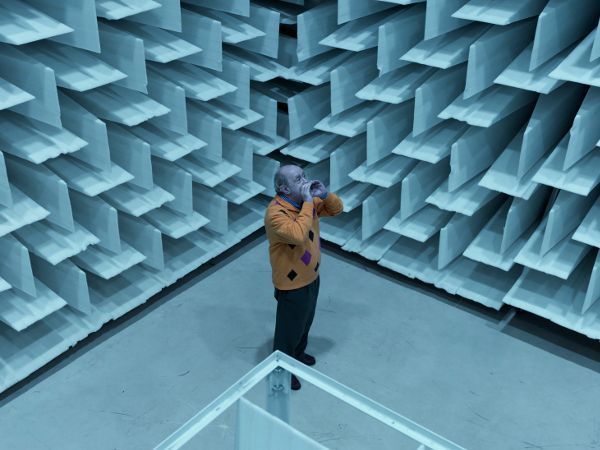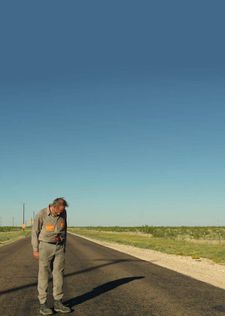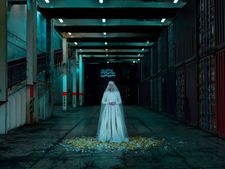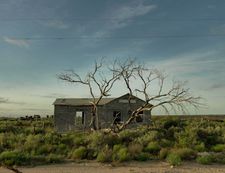 |
| Giorgio Ferrero: 'The objects are compressing our lives and I decided to create a dichotomy between our oppressive life with the objects and the silent life around the characters' |
Ferrero spoke to me from Venice Film Festival, where his film is one of this year's three films to benefit from the Biennale College mentoring and development system, alongside Strange Colours and Martyr.
Can we start by talking about the music and sound design because it’s such a crucial element. You come from the collective Mybosswas, so you’ve done this sort of thing before. When you approach the material, do you come to it from the music perspective – thinking how that will happen – or from the documentary hybrid aspect?
 |
| 'When I started to write my movie, I started from an idea of a psychological story based on sounds' |
For example, when you see in the last actor, Vito, walking inside his cathedral of cement, I put inside the pocket of the DoP a little speaker with a clock and with the playback for his walking because I needed to mix together the rhythm of the images and the rhythm of music.
So you needed him to mimic the music. It’s interesting that you refer to him as an actor, where does the line between the documentary and the acting fall?
All the stories are real. I started with a study of these type of characters, reading books and taking interviews with some shipmen or oilmen around the world. I started to write a story with these elements. When I found the final characters, I found the key point between their story and the story that I had in mind and I wrote the monologue with them after a lot of interviews. All the words that you have are from them but they are also the result of a lot of work together around their lives. Also, I put some iconic stories inside the specific stories. For example, when Danilo is telling the monkey episode, he was not there on that ship but the monkey story is one of the most important stories that every shipman of this company tells. When you ask them, what is the strangest object that you had on the ship, everybody says, ‘One time, one of our ships some colleagues found a monkey’. It’s a very common story, so I decided to put in some of these little parts in that are very iconic for their work.
 |
| 'I identified the peculiarity of the sounds of each character and started from that' |
I didn’t decide to make a male movie but if you think about the extreme jobs that exist around our everyday consumption, you can imagine that they are all masculine jobs. It’s a thing of our society. I don’t want to say it’s right or not but it’s real. In the oil field, you can’t find a woman, it’s impossible. When you read my text before the cargo episode, I wrote there are only 25 men, not people. When we shot inside the cargo ship, the master asked me only one thing, “Please don’t come inside a with a woman because that’s a problem”. So that’s a real male world. I don’t like this fact, but in the science world near the consumption – not the university world or research world – is governed by men. I don’t know why, but it’s real. Also, in the incinerator plant, it’s impossible that you would find a woman pushing the waste inside the oven.
Maybe that’s why I decided to use a woman as part of the framing story – which is based on my real life because this is my house and where I live. The first scene is inside my child’s room.
Talking about those scenes, I felt as though we were time travelling in them, from the Eighties onwards.
I chose this story because, for me, this is the real documentary part because it’s my life. I decided to describe it because I am 37 years old and I think my generation is a symbolic generation. My generation started childhood from the point of view of a dreamer inside the robots. In 20 years, we became the first generation with an emancipation, growing up with sexual activity on the internet – we are the first. And now, we are the first generation who create work based on digital and social media. So I think we are a symbol of our society. I decided directly to use my house and my story because I think I am the first sinner. The movie started from my own introspection and my self-analysis of my way of life.
It does scrutinise modern life because the first house scenes are so cluttered and you notice the stark contrast between that and the wide open spaces of the desert where the oil is being pumped or the open spaces of the cargo ship. That also plays into the idea of silence that runs through the movie. Those framing scenes are deliberately noisy, quite discordant, almost like a horror film, then you go to these wider spaces.
 |
| Giorgio Ferrero: 'The movie started from my own introspection and my self-analysis of my way of life' |
As well as being a symphony of music, it’s a symphony of things. The objects all have their own ‘note’ which builds to a rather less tuneful crescendo than the music. Were you inspired by the ideas of a slot machine or banging on pipes in the desert to try to recreate those.
Yes, from the real stories. When Vito told me that in a previous life he was a manager of slot machines, I thought, ‘This is the sound of your memory’. I wanted to play with it. When I read for the first time that all the children in the oil field community play a lot with the pumpjacks after school, I thought about this idea. Also, when Van told me that his childhood passion was rhythm and his dream was to be a drummer, I thought, "This is your sound".
I'm interested in the way that there are sort of 'pre-echoes' of the music that will finally come. That when we get towards the end and you are showing us the child's glockenspiel made with wrenches or the slot machine, we already feel as though we are familiar with those sounds because you've been using some of them from the very start. This idea of a kind of continuum that we are all on (perhaps even a production line) was that something that was in your mind from the start? And, if so, how hard is it to achieve this.
Yes, this is one of the most important concepts of the movie from the beginning. I decided to try to tell a story through the sounds of the memory of the characters. Sounds, notes, silences and words had the same weight inside the screenplay and obviously inside the movie. We wrote 70 per cent of the music before the shooting, because of the necessity to control the rhythm of the climax. We thought about the movie like a contemporary opera, for me the screenplay was at first a score not a textual narrative.
A lot of steps of the story are told without words... it was hard work, enough to make me crazy, I spent a lot of days writing and rewriting words and music to find the right tune and the right rhythm. This is the strongest creative experience of my life.
Perhaps you could tell me a bit about incorporating the more obvious performance art within the film - such as the man and woman in the shopping centre (a cathedral of consumerism) at the end?
The 'square' frame story inside the movie it's my life. I shot my house, my child's room, one of the shopping malls where usually I go to buy objects. This is my life and I wrote this movie to push the audience only to think about their life and their habitat without political answers - only to create a virtual exit, during an hour-and-a-half, from the compression and the acceleration of our everyday life. The last scene was the most difficult decision to take. I decided to leave a positive door from which to restart to live in a happy way with the objects and ourselves. This is my hope, the hope for my family. A freedom life based on a right balance between us and the acceleration and the noise of the objects.
Beautiful Things is screening at Edinburgh International Film Festival





















